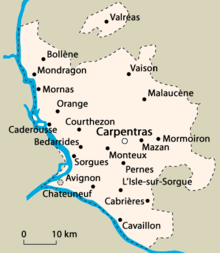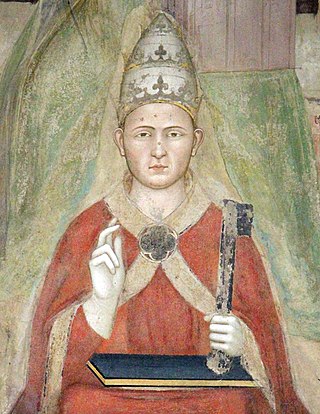
Pope Clement V, born Raymond Bertrand de Got, was head of the Catholic Church and ruler of the Papal States from 5 June 1305 to his death, in April 1314. He is remembered for suppressing the order of the Knights Templar and allowing the execution of many of its members. A Frenchman by birth, Clement moved the Papacy from Rome to Avignon, ushering in the period known as the Avignon Papacy.

The Avignon Papacy was the period from 1309 to 1376 during which seven successive popes resided in Avignon rather than in Rome. The situation arose from the conflict between the papacy and the French crown, culminating in the death of Pope Boniface VIII after his arrest and maltreatment by Philip IV of France. Following the subsequent death of Pope Benedict XI, Philip forced a deadlocked conclave to elect the French Clement V as pope in 1305. Clement refused to move to Rome, and in 1309 he moved his court to the papal enclave at Avignon, where it remained for the next 67 years. This absence from Rome is sometimes referred to as the "Babylonian captivity" of the Papacy.
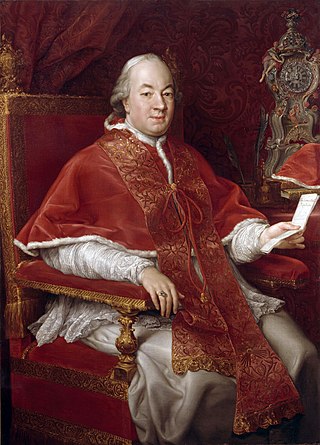
Pope Pius VI was head of the Catholic Church and ruler of the Papal States from 15 February 1775 to his death in August 1799.

The Papal States, officially the State of the Church, were a conglomeration of territories on the Italian Peninsula under the direct sovereign rule of the Pope from 756 to 1870. They were among the major states of Italy from the 8th century until the Unification of Italy, which took place between 1859 and 1870, and culminated in their demise.

The Holy See exercised sovereign and secular power, as distinguished from its spiritual and pastoral activity, while the pope ruled the Papal States in central Italy.
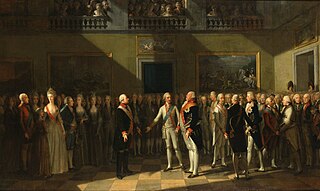
The Declaration of Pillnitz was a statement of five sentences issued on 27 August 1791 at Pillnitz Castle near Dresden (Saxony) by Frederick William II of Prussia and the Habsburg Leopold II, Holy Roman Emperor who was Marie Antoinette's brother. It declared the joint support of the Holy Roman Empire and of Prussia for King Louis XVI of France against the French Revolution.
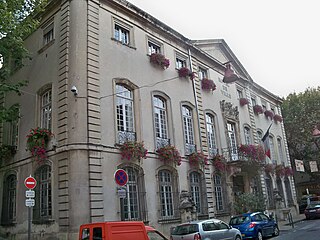
Carpentras is a commune in the Vaucluse department in the Provence-Alpes-Côte d'Azur region in southeastern France.
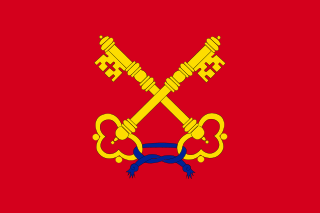
The Comtat Venaissin, often called the Comtat for short, was a part of the Papal States from 1274 to 1791, in what is now the Provence-Alpes-Côte d'Azur region of Southern France.

The Treaty of Tolentino was a peace treaty between Revolutionary France and the Papal States, signed on 19 February 1797 and imposing terms of surrender on the Papal side. The signatories for France were the French Directory's Ambassador to the Holy See, François Cacault, and the rising General Napoleon Bonaparte and opposite them four representatives of Pope Pius VI's curia.

The canton of Valréas, sometimes called the enclave des Papes, is a canton of the Vaucluse department, a part of the Provence-Alpes-Côte d'Azur (PACA) region in Southern France. It consists of four communes: Grillon, Richerenches, Valréas and Visan.

Carpentras was a diocese of the Roman Catholic Church in the Provence region, from the later Roman Empire until 1801. It was part of the ecclesiastical province under the Metropolitan, the Archbishop of Arles. The bishop was a major figure in the Comtat Venaissin, and a member of the Estates of the Comtat. He was a direct appointee of the pope.
The massacres of La Glacière that took place during 16–17 October 1791 in the Tour de la Glacière of the Palais des Papes at Avignon, then recently united to France, were an isolated and early example of violence in the opening phase of the French Revolution; the massacres are interpreted by French historians not as presaging the September massacres of 1792 and the Reign of Terror but as a last episode in the struggle between partisans and advocates of the reunion of the papal enclave of Avignon and the Comtat Venaissin with the state of France.
Hachmei Provence refers to the hekhamim, "sages" or "rabbis," of Provence, now Occitania in France, which was a great center for Rabbinical Jewish scholarship in the times of the Tosafists. The singular form is hakham, a Sephardic and Hachmei Provençal term for a rabbi.

The papal conclave held from 1 May 1314 to 7 August 1316 in the apostolic palace of Carpentras and then the Dominican house in Lyon was one of the longest conclaves in the history of the Roman Catholic Church and the first conclave of the Avignon Papacy. The length of the conclave was due to the division of the cardinals into three factions: Italian, Gascon, and French/Provençal.

The 1304–1305 papal conclave was initiated after the death of Pope Benedict XI in July 1304. The conclave took place in Perugia, the city in which Benedict had died, and proved to be a protracted affair. It ran from 10 or 17 July 1304 to 5 June 1305, and ultimately elected the non-cardinal Raymond Bertrand de Got as Pope Clement V. At the time of his election de Got was Archbishop of Bordeaux, and thus a subject of Edward I, King of England, although he was a childhood friend of Philip IV of France. Clement V's decision to relocate the papacy to France was one of the most contested issues in the papal conclave following his 1314 death, during which the minority of Italian cardinals were unable to engineer the return of the papacy to Rome. This immediately preceded the beginning of the Avignon Papacy.

Joseph-Henri baron de Jessé (1755–1794) was a French nobleman and government official, who served as president of the French National Constituent Assembly from 30 August 1790 to 10 September 1790.

The Castle of Châteauneuf-du-Pape is a château located in the town of the same name in southeastern France. Its presence has dominated the landscape around the village and its renowned vineyards for more than 800 years.
Jean de Tulles was a French prelate, latterly bishop of Orange.

The following is a history of Avignon, France.

Following the unanimous declaration of the various district assemblies of Avignon on 12 June 1790, to secede from the Papal States and unite with France, war broke out between the municipal government of Avignon and the more conservative Comtat Venaissin, the larger county (comtat) which co-existed with Avignon and still pledged loyalty to the Papal States. Avignon, which had been inspired by the intentions of the French Revolution, soon received the support of French troops placed under its control, augmenting the Avignon forces that had laid siege to Carpentras, ending the government of the Comtat. However, hardline counter-revolutionary regions of the Comtat under the name the "Union of St. Cecilia" continued fighting until June 1791.


